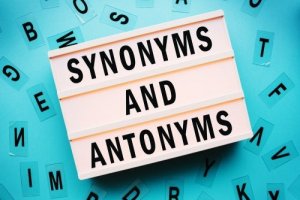How to Explain Synonyms and Antonyms to Children


Written and verified by the teacher Ana María Ruiz Sánchez
Children need to gradually expand their vocabulary. On the one hand, they’ll do so as they acquire more knowledge of the world around them. On the other hand, using synonyms and antonyms of the words children already know will help them.
You can start working synonyms and antonyms with children from age five, when children already handle a vocabulary of approximately 3,500 words. This way, you’ll help them develop their verbal skills.
The definition of synonyms
Synonyms are words that have the same or very similar meanings, but are spelled differently. It’s important to note that synonyms have varying degrees and that not all of them can be used in the same contexts.
They’re words that people use to avoid repeating the one they already resorted to. An example of two synonyms is home and residence.

The definition of antonyms
Antonyms are words with an opposite or contrary meaning, such as happy and sad. Sometimes, antonyms are created by adding a prefix, such as comfortable and uncomfortable.
Synonyms and antonyms games for children
Playing is, undoubtedly, the best way to learn. Therefore, we decided to share some ideas that can help children understand the meaning and use of synonyms and antonyms.
Identify the emotion
With this game, besides working on synonyms and antonyms, you can work on emotions with your children. To do this, write the names of emotions, such as joy, happiness, sadness, and anger, among others, on cards. Then, ask your child to choose a card and identify the type of emotion (positive, negative, pleasant, unpleasant…).
After that, they must select all the cards that contain a similar emotion. If you want, you can explain to your child what a synonym is, depending on their age.
Having identified similar emotions, you can focus on the opposite ones to those on the chosen cards and explain what antonyms are to your child, if you like.
Groups of words
For this game, all you have to do is write four or five synonyms and one antonym inside a circle. Ask your child to read every word and mark the ones that don’t have the same meaning.
Crossword puzzles
On the Internet, you can find tools that allow you to make your own crossword puzzles. Thus, you can adapt them to your child’s age and knowledge. If you have several children of similar ages, you can even organize a competition.
Images game
If your children can’t read or write yet, you can work on these concepts with drawings. It consists of telling your child a word and making them look for an image that resembles the word the most and another that represents the opposite. Let them express the synonym and the corresponding antonym, based on the images they chose.

Interactive games
You can find many interactive games online that help you work on any concept you want. They’re especially useful for working grammar. In addition, using a mouse and keyboard also helps children develop their motor skills.
However, there should always be an adult present while the child is using the computer. In addition, they should never exceed the recommended screen time for every age.
Exercises with synonyms and antonyms for children
With older children (between the ages of nine and ten), you can occasionally do an exercise after a joint reading to encourage the use of synonyms and antonyms, as well as verbal reasoning. You can ask your children to look for synonyms or antonyms in the text or to think of some themselves after reading.
You can also ask them to substitute one word for another so that they can experiment and understand the use of total and contextual synonyms.
Conclusion
Knowing language implies knowing the use and meaning of words. Therefore, it’s important for children to start using synonyms and antonyms from a young age.
This will help them express themselves better because they’ll feel they have enough resources to function in a variety of contexts.
Children need to gradually expand their vocabulary. On the one hand, they’ll do so as they acquire more knowledge of the world around them. On the other hand, using synonyms and antonyms of the words children already know will help them.
You can start working synonyms and antonyms with children from age five, when children already handle a vocabulary of approximately 3,500 words. This way, you’ll help them develop their verbal skills.
The definition of synonyms
Synonyms are words that have the same or very similar meanings, but are spelled differently. It’s important to note that synonyms have varying degrees and that not all of them can be used in the same contexts.
They’re words that people use to avoid repeating the one they already resorted to. An example of two synonyms is home and residence.

The definition of antonyms
Antonyms are words with an opposite or contrary meaning, such as happy and sad. Sometimes, antonyms are created by adding a prefix, such as comfortable and uncomfortable.
Synonyms and antonyms games for children
Playing is, undoubtedly, the best way to learn. Therefore, we decided to share some ideas that can help children understand the meaning and use of synonyms and antonyms.
Identify the emotion
With this game, besides working on synonyms and antonyms, you can work on emotions with your children. To do this, write the names of emotions, such as joy, happiness, sadness, and anger, among others, on cards. Then, ask your child to choose a card and identify the type of emotion (positive, negative, pleasant, unpleasant…).
After that, they must select all the cards that contain a similar emotion. If you want, you can explain to your child what a synonym is, depending on their age.
Having identified similar emotions, you can focus on the opposite ones to those on the chosen cards and explain what antonyms are to your child, if you like.
Groups of words
For this game, all you have to do is write four or five synonyms and one antonym inside a circle. Ask your child to read every word and mark the ones that don’t have the same meaning.
Crossword puzzles
On the Internet, you can find tools that allow you to make your own crossword puzzles. Thus, you can adapt them to your child’s age and knowledge. If you have several children of similar ages, you can even organize a competition.
Images game
If your children can’t read or write yet, you can work on these concepts with drawings. It consists of telling your child a word and making them look for an image that resembles the word the most and another that represents the opposite. Let them express the synonym and the corresponding antonym, based on the images they chose.

Interactive games
You can find many interactive games online that help you work on any concept you want. They’re especially useful for working grammar. In addition, using a mouse and keyboard also helps children develop their motor skills.
However, there should always be an adult present while the child is using the computer. In addition, they should never exceed the recommended screen time for every age.
Exercises with synonyms and antonyms for children
With older children (between the ages of nine and ten), you can occasionally do an exercise after a joint reading to encourage the use of synonyms and antonyms, as well as verbal reasoning. You can ask your children to look for synonyms or antonyms in the text or to think of some themselves after reading.
You can also ask them to substitute one word for another so that they can experiment and understand the use of total and contextual synonyms.
Conclusion
Knowing language implies knowing the use and meaning of words. Therefore, it’s important for children to start using synonyms and antonyms from a young age.
This will help them express themselves better because they’ll feel they have enough resources to function in a variety of contexts.
All cited sources were thoroughly reviewed by our team to ensure their quality, reliability, currency, and validity. The bibliography of this article was considered reliable and of academic or scientific accuracy.
- A. (2014). 10 Ejemplos de Sinónimos y Antónimos. Disponible en https://10ejemplos.com/10-ejemplos-de-sinonimos-y-antonimos/
- Garrido, M., Rodríguez, A., Rodríguez, R. y Sánchez, A. (2006). Guía de atención temprana: el niño y la niña de tres a seis años. La Rioja: Consejería de Educación, Cultura y Deporte
- Mendoza Fillola, A. et al. (2003). Didáctica de la Lengua y la Literatura para Primaria. Madrid: Pearson Education.
- Pérez Pereira, M. (2004). Desarrollo del lenguaje. En J. Palacios, A. Marchesi, C. Coll (Eds.), Desarrollo psicológico y educación: Psicología Evolutiva. Madrid: Alianza Editorial.
This text is provided for informational purposes only and does not replace consultation with a professional. If in doubt, consult your specialist.








